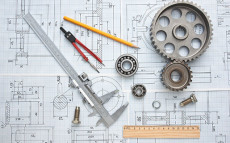- pathfindersAI
- Job Profile
Electrical and Electronics Drafters
Summary
Electrical and Electronics Drafters: Crafting the Future of Technology
What They Do
Electrical and Electronics Drafters play a pivotal role in the engineering and manufacturing industries. These professionals create detailed technical drawings and plans that the engineers and technicians rely on to construct or repair electrical systems and electronic devices. They transform abstract concepts and preliminary designs into precise schematics, wiring diagrams, and layout drawings. The work of Electrical and Electronics Drafters covers a broad spectrum, ranging from the intricacies of microelectronics to the expansive grids of electrical distribution systems. By using specialized computer-aided design (CAD) software, they ensure that the blueprints and diagrams are not only accurate but also adherent to industry standards and regulatory requirements.
Job Responsibilities
The primary responsibilities of Electrical and Electronics Drafters revolve around developing and preparing engineering drawings based on rough sketches, specifications, and calculations from engineers. They meticulously draft detailed schematics of electrical circuits, creating layouts for electrical wiring and harnesses, and designing printed circuit boards (PCBs). Drafters are tasked with integrating these drawings with other complex design documents to ensure cohesion and functionality. Furthermore, they are responsible for reviewing and revising drawings to reflect changes made during the production process and for producing accompanying documentation that explains the purpose and construction of each design. Another significant aspect of the role includes collaborating with engineers, manufacturers, and other team members to resolve design issues and to provide clear, actionable diagrams.
Essential Skills
To excel as an Electrical and Electronics Drafter, a robust set of skills is essential. Proficiency in CAD software is paramount, as it forms the backbone of most drafting work. Analytical skills are crucial in interpreting designs and technical information, enabling drafters to produce precise and functionally sound schematics. Attention to detail is vital since even minor errors can lead to significant problems in the production process. Good communication skills facilitate effective collaboration with engineers and other stakeholders, ensuring that all project requirements are thoroughly understood and met. Familiarity with industry standards and regulations is also necessary to ensure compliance and safety. These professionals must also possess a solid foundation in electrical and electronics theory to comprehend the practical application of their designs.
Educational Pathways
Becoming an Electrical and Electronics Drafter typically requires an educational background that includes both theoretical knowledge and practical training. Most positions require at least an associate degree in drafting, engineering technology, or a related field. These programs generally cover principles of electronics, digital logic, microprocessor systems, and CAD software, often supplemented with courses in mathematics and physical sciences. Some institutions also offer bachelor's degrees in engineering technology with a specialization in drafting. Furthermore, certifications from recognized organizations, such as the American Design Drafting Association (ADDA), can enhance a drafter's credentials and employment prospects. Internships and cooperative education programs provide valuable hands-on experience, bridging the gap between academic learning and professional practice.
Career Prospects
The demand for Electrical and Electronics Drafters is closely tied to the growth of industries that rely on advanced electrical systems and electronic devices. As technology continues to evolve, the need for skilled drafters who can keep pace with innovations remains robust. Employment opportunities can be found in various sectors, including manufacturing, engineering services, telecommunications, and utilities. With experience, drafters can advance into more specialized roles or supervisory positions, overseeing teams of drafters and technicians. Some may choose to further their education and transition into engineering roles. According to the Bureau of Labor Statistics, the median annual salary for drafters is competitive, and job prospects are projected to remain steady, with variations based on geographic location and industry demand.
Conclusion
Electrical and Electronics Drafters are essential to the infrastructure of modern technology, acting as the bridge between conceptual designs and tangible products. Their expertise in crafting detailed and precise technical drawings ensures the seamless execution of complex electrical and electronic systems. With the right blend of education, skills, and experience, a career in drafting offers not only job stability but also the opportunity to contribute significantly to technological advancements. For those with a passion for precision and a keen eye for detail, the field of Electrical and Electronics Drafting presents a promising and fulfilling career path.
Video
Compensation
| State | Median Salary | Median Hourly | Positions |
|---|---|---|---|
| AL | 61,910 | 29.76 | 270 |
| AK | * | * | 80 |
| AZ | 63,310 | 30.44 | 730 |
| AR | 66,980 | 32.20 | 60 |
| CA | 73,900 | 35.53 | 3,160 |
| CO | 77,910 | 37.46 | 630 |
| CT | 68,970 | 33.16 | 420 |
| DE | 64,480 | 31.00 | 50 |
| DC | 82,850 | 39.83 | 50 |
| FL | 61,090 | 29.37 | 930 |
| GA | 72,360 | 34.79 | 580 |
| HI | 58,710 | 28.23 | 100 |
| ID | 60,620 | 29.14 | 30 |
| IL | 67,360 | 32.39 | 240 |
| IN | 68,800 | 33.08 | 170 |
| IA | 66,170 | 31.81 | 100 |
| KS | 83,200 | 40.00 | 620 |
| KY | 59,160 | 28.44 | 200 |
| LA | 55,320 | 26.60 | 300 |
| ME | 72,820 | 35.01 | 60 |
| MD | 80,480 | 38.69 | 160 |
| MA | 70,310 | 33.81 | 160 |
| MI | 63,720 | 30.64 | 550 |
| MN | 66,790 | 32.11 | 180 |
| MS | 57,200 | 27.50 | 120 |
| MO | 76,060 | 36.57 | 420 |
| MT | 62,310 | 29.96 | 60 |
| NE | 66,670 | 32.05 | 150 |
| NV | 68,740 | 33.05 | 130 |
| NH | 81,210 | 39.04 | 150 |
| NJ | 76,740 | 36.89 | 410 |
| NM | 83,870 | 40.32 | 290 |
| NY | 83,210 | 40.01 | 950 |
| NC | 67,030 | 32.22 | 550 |
| OH | 79,680 | 38.31 | 880 |
| OK | 67,230 | 32.32 | 320 |
| OR | 69,230 | 33.29 | 190 |
| PA | 76,680 | 36.86 | 580 |
| SC | 61,810 | 29.72 | 410 |
| SD | 52,320 | 25.15 | 30 |
| TN | 68,370 | 32.87 | 400 |
| TX | 64,320 | 30.92 | 2,910 |
| UT | 49,830 | 23.96 | 230 |
| VA | 67,310 | 32.36 | 440 |
| WA | 73,910 | 35.53 | 490 |
| WI | 62,550 | 30.07 | 560 |
Similar Occupations
In this area you will find other occupations that are close to the one you were viewing in tasks, knowledge and work environment. If the primary job profile you are viewing isn't quite to your liking, take a look around and see what else is available.
Basic and Premium Accounts have more alternative occupations available than the Free account.

Architectural and Civil Drafters - 17-3011.00
Architectural and Civil Drafters create detailed technical drawings and plans used in the construction of buildings and infrastructure projects, translating designers' and engineers' ideas into precise documentation. They use computer-aided design (CAD) software to produce layouts, measurements, and specifications to guide construction activities.
-
$61,820/yr
Median Pay -
111,070
Number of Jobs

Calibration Technologists and Technicians - 17-3028.00
Calibration Technologists and Technicians are responsible for testing, maintaining, and adjusting precision instruments and equipment to ensure their accuracy and functionality. They meticulously calibrate a variety of devices, ensuring they meet established standards and specifications necessary for optimal performance.
-
$62,790/yr
Median Pay -
13,220
Number of Jobs